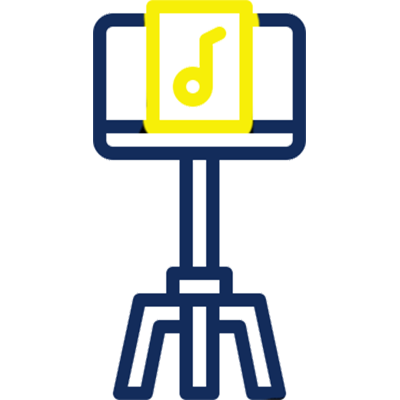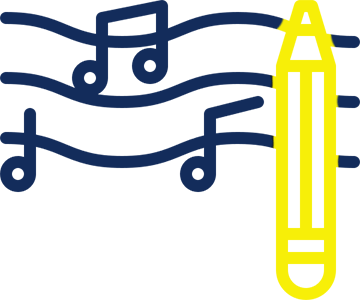Diploma in Sound Engineering
Diploma in
Sound Engineering
Best Sound Engineering Diploma course Mumbai 2024
Eligibility Criteria
- Minimum Age: 16 years and above
- Educational Background: Class 10th/High school or equivalent
- Basic Knowledge:Some prior knowledge or experience in music, sound or audio production (though not mandatory, this can be an added advantage).
- Language Proficiency: Basic proficiency in English and Hindi for understanding technical concepts and instructions.
- Passion for Career in Sound: A demonstrated interest or passion for Sound Engineering which could be shown through a portfolio or personal projects.
- Basic Computer Skills : Familiarity with using computers and basic software.
- Minimum Age: 16 years and above
- Educational Background: Class 10th/High school or equivalent
- Basic Knowledge: Some prior knowledge or experience in music, sound or audio production (though not mandatory, this can be an added advantage).
- Language Proficiency: Basic proficiency in English and Hindi for understanding technical concepts and instructions.
- Passion for Career in Sound: A demonstrated interest or passion for Sound Engineering which could be shown through a portfolio or personal projects.
- Basic Computer Skills : Familiarity with using computers and basic software.
Course Curriculum
This course will prepare the students to understand the concepts of Sound Engineering right from the Beginners to an Advanced level as per the Industry requirements.
- Vibrations to Sound
- Propagation of Sound
- Speed of Sound
- Waveforms – Sine, Square, Triangle, Sawtooth, Semisine
- Amplitude, Wavelength, Frequency, Calculation of Wavelength from frequency
- Human Hearing & Psychoacoustics
- Concept
- Types – Vu, dBFS, PPM, LUFS, the ‘K’ System
- Phase, Stereo Spread, Spectral Analysis
- Applications
- Types
- Construction & Principle
- Polar Patterns
- Microphone Techniques
- Stereo Microphone Techniques
- Signal Path
- Analogue and Digital Consoles
- Inline and Split Consoles
- Channel Strips
- Input and Output Routing
- Auxes and Busses
- Master Section
- Control Surfaces
- Introduction
- Menus, Options and Preferences
- Input & Output Routing
- ASIO & CORE Audio Optimisation
- Toolbars & Transport
- Tracks – Audio, MIDI, Instrument
- DAW Console
- Signal Routing (internal & external)
- Bus & Aux
- Plugins
- Master Section
- Editing & Fades
- Keyboard Shortcuts
- Session Pool & File Management
- Importing & Exporting Files & Session
- Rendering Options
- Microphone Placement Techniques (Practicals)
- Input Gain (Consoles & Preamps)
- Lead Vocal
- Backing Vocals & Chorus
- String Instruments
- Wind Instruments
- Percussion Instruments
- Drums
- Speaker (Guitars & Bass)
- Studio Session Management
- Concept
- Concept of Balance
- Levels – Dynamic Range – Using Compression and Gain
- Tonal – EQ
- Ambience – Reverb
- Modulation – Delay, Flange, Phasing, Distortion
- Panorama
- Concept and PAN Law
- L-C-R Panning
- Mix in Mono
- Phase Consistency
- The Master Channel
- Delivery of Mix and Formats
- Concept
- Sound Design
- Foley effects
- Film and Video Formats
- Sync & Non Sync Effects, Digetic/Non-Diegetic Sounds, Leitmotif
- Track Laying – Practicals
- Foley – Practicals
- Sync, Non-Sync, Diegetic/Non-Diegetic Sounds
- Location Sound
- ADR
- Concept
- dB SPL, dBv, dBu, dBm
- Dynamic Range, Signal to Noise Ratio, Headroom
- Weighted Average (dBa, dBc)
- Boundary Effect
- Inverse Square Law – Demonstration using a Loudspeaker
- Impedance, Standard Operating Levels
- Cables
- Connectors
- Applications
- Soldering Cables & Connectors (Practical)
- Using a Multimeter (Practical)
- Types – Active, Passive
- Drive Units
- Crossovers
- Cabinets
- Wiring & Setups
- Placement Setup & Calibration for Stereo, 5.1, 7.1, Auro 3D & Atmos
- A/D – D/A Conversion
- Sample Rate, Bit Depth, Bitrate
- Quantization, Dither
- Nyquist
- Digital Protocols
- Digital Cables
- Introduction to Acoustics
- Absorption, Diffusion, Reflection
- Isolation
- Room Modes
- RT-60
- Sepermeryer Ratios
- Studio Construction – Walls and Partitions
- Introduction to Acoustics
- Absorption, Diffusion, Reflection
- Isolation
- Room Modes
- RT-60
- Sepermeryer Ratios
- Studio Construction – Walls and Partitions
- Design Layout
- Sound Proofing,
- Acoustic Treatment – Panels
- Wiring Layout for Audio
- Wiring Layout for Electricals
- Electrical Load Distribution and Circuits
- Door and Windows
- Air Conditioning
- Room Calibration
- Studio Construction Project (Virtual)
- Dynamics
- EQ
- Reverbs
- Delay
- Phasing
- Flanging
- Distortion
- Stereo Spread
- Gain and Amplification
- Parallel Processing
- Signal Drive
- Saturation
- Concept
- Mastering vs Mixing
- Prerequisites for a Mastering Session
- Audio Restoration
- Mastering Chain (Analogue and Digital)
- Stereo Imaging
- Volume, Loudness and Limiting
- Dither
- Delivery File Formats
- Understanding Live Sound
- Open Air vs Closed Space Acoustics
- Live Sound Equipments
- Line Array Systems
- Power Requirements
- Preparing and Managing a Live Session
- Dialogue Cleaning
- Session Management
- Mixing – Stereo, 5.1, 7.1 & Dolby Atmos
- Delivery for OTT, Broadcast & Theatre
VIVAs : Interactive sessions where students will discuss their projects and demonstrate their understanding of key concepts.
Project Submissions: Students are required to submit projects that reflect their learning and skills gained throughout the course.
Assignments: Regular assignments will be evaluated to gauge ongoing progress and understanding of course material.
Course Curriculum
This course will prepare the students to understand the concepts of Sound Engineering right from the Beginners to an Advanced level as per the Industry requirements.
- Vibrations to Sound
- Propagation of Sound
- Speed of Sound
- Waveforms – Sine, Square, Triangle, Sawtooth, Semisine
- Amplitude, Wavelength, Frequency, Calculation of Wavelength from frequency
- Human Hearing & Psychoacoustics
- Concept
- dB SPL, dBv, dBu, dBm
- Dynamic Range, Signal to Noise Ratio, Headroom
- Weighted Average (dBa, dBc)
- Boundary Effect
- Inverse Square Law – Demonstration using a Loudspeaker
- Impedance, Standard Operating Levels
- Concept
- Types – Vu, dBFS, PPM, LUFS, the ‘K’ System
- Phase, Stereo Spread, Spectral Analysis
- Applications
- Cables
- Connectors
- Applications
- Soldering Cables & Connectors (Practical)
- Using a Multimeter (Practical)
- Types
- Construction & Principle
- Polar Patterns
- Microphone Techniques
- Stereo Microphone Techniques
- Types – Active, Passive
- Drive Units
- Crossovers
- Cabinets
- Wiring & Setups
- Placement Setup & Calibration for Stereo, 5.1, 7.1, Auro 3D & Atmos
- Signal Path
- Analogue and Digital Consoles
- Inline and Split Consoles
- Channel Strips
- Input and Output Routing
- Auxes and Busses
- Master Section
- Control Surfaces
- A/D – D/A Conversion
- Sample Rate, Bit Depth, Bitrate
- Quantization, Dither
- Nyquist
- Digital Protocols
- Digital Cables
- Introduction
- Menus, Options and Preferences
- Input & Output Routing
- ASIO & CORE Audio Optimisation
- Toolbars & Transport
- Tracks – Audio, MIDI, Instrument
- DAW Console
- Signal Routing (internal & external)
- Bus & Aux
- Plugins
- Master Section
- Editing & Fades
- Keyboard Shortcuts
- Session Pool & File Management
- Importing & Exporting Files & Session
- Rendering Options
- Introduction to Acoustics
- Absorption, Diffusion, Reflection
- Isolation
- Room Modes
- RT-60
- Sepermeryer Ratios
- Studio Construction – Walls and Partitions
- Introduction to Acoustics
- Absorption, Diffusion, Reflection
- Isolation
- Room Modes
- RT-60
- Sepermeryer Ratios
- Studio Construction – Walls and Partitions
- Design Layout
- Sound Proofing,
- Acoustic Treatment – Panels
- Wiring Layout for Audio
- Wiring Layout for Electricals
- Electrical Load Distribution and Circuits
- Door and Windows
- Air Conditioning
- Room Calibration
- Studio Construction Project (Virtual)
- Microphone Placement Techniques (Practicals)
- Input Gain (Consoles & Preamps)
- Lead Vocal
- Backing Vocals & Chorus
- String Instruments
- Wind Instruments
- Percussion Instruments
- Drums
- Speaker (Guitars & Bass)
- Studio Session Management
- Dynamics
- EQ
- Reverbs
- Delay
- Phasing
- Flanging
- Distortion
- Stereo Spread
- Gain and Amplification
- Parallel Processing
- Signal Drive
- Saturation
- Concept
- Concept of Balance
- Levels – Dynamic Range – Using Compression and Gain
- Tonal – EQ
- Ambience – Reverb
- Modulation – Delay, Flange, Phasing, Distortion
- Panorama
- Concept and PAN Law
- L-C-R Panning
- Mix in Mono
- Phase Consistency
- The Master Channel
- Delivery of Mix and Formats
- Concept
- Mastering vs Mixing
- Prerequisites for a Mastering Session
- Audio Restoration
- Mastering Chain (Analogue and Digital)
- Stereo Imaging
- Volume, Loudness and Limiting
- Dither
- Delivery File Formats
- Understanding Live Sound
- Open Air vs Closed Space Acoustics
- Live Sound Equipments
- Line Array Systems
- Power Requirements
- Preparing and Managing a Live Session
- Concept
- Sound Design
- Foley effects
- Film and Video Formats
- Sync & Non Sync Effects, Digetic/Non-Diegetic Sounds, Leitmotif
- Track Laying – Practicals
- Foley – Practicals
- Sync, Non-Sync, Diegetic/Non-Diegetic Sounds
- Location Sound
- ADR
- Dialogue Cleaning
- Session Management
- Mixing – Stereo, 5.1, 7.1 & Dolby Atmos
- Delivery for OTT, Broadcast & Theatre
VIVAs : Interactive sessions where students will discuss their projects and demonstrate their understanding of key concepts.
Project Submissions: Students are required to submit projects that reflect their learning and skills gained throughout the course.
Assignments: Regular assignments will be evaluated to gauge ongoing progress and understanding of course material.
Career Opportunities in Sound Engineering
Upon completion of the Diploma in Sound Engineering, Students will be prepared for several exciting roles within the Music and Sound industry, including :
Career Opportunities in Sound Engineering
Post-production Engineer
Radio Sound Engineer
Sound Effects Designer (Foley Artist)
Mixing Engineer
Mastering Engineer
Recording Engineer
Studio Acoustic engineer
Sound Editor
Educator
Frequently Asked Questions
No prior experience is required. The course is designed for beginners, though having a passion for music and sound will be helpful.
After completing the diploma, you can work as a sound engineer, music producer, mixing/mastering engineer, live sound technician, sound designer for films or games, or even start your own studio.
You will get hands-on experience with industry-standard equipment, including DAWs (Digital Audio Workstations), microphones, mixers and other professional audio gears as well as opportunities to work on real-world projects.
While it’s not mandatory to have your own equipment, having a basic setup (such as a computer with a DAW and headphones) for practice at home is recommended to enhance your learning experience.
Yes, there will be Vivas, assessments and practical exams including project submissions throughout the course to evaluate your progress.
Yes, upon successful completion of the course, you will be awarded a Diploma in Sound Engineering.
Yes, we offer flexible payment options with installment plans
Yes, students will have access to our professional studios for practice and project work.
We provide internships and placement opportunities for Studios, Production houses, and Record labels as well as projects for Films, OTT platforms, Television shows, Radio industry, etc.



